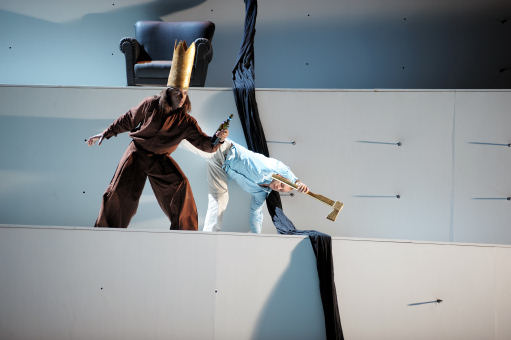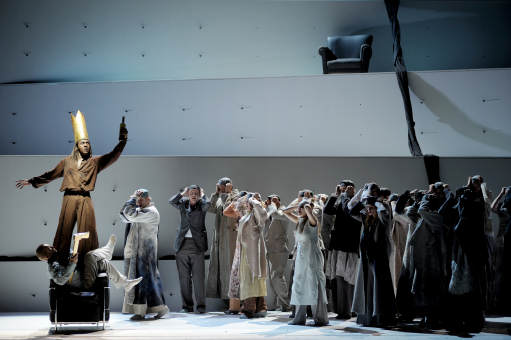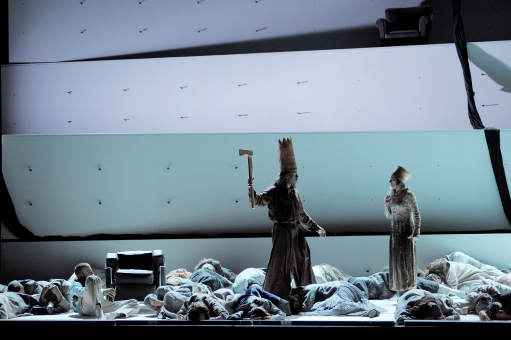Other Links
Editorial Board
- Editor - Bill Kenny
Founder - Len Mullenger
Google Site Search
SEEN
AND HEARD INTERNATIONAL OPERA REVIEW
Handel, Belshazzar:
Production from the Staatsopera Berlin, soloists of
the Festival d'Aix-en-Provence, chorus RIAS-Kammerchor,
orchestra Akademie für Alte Musik Berlin, René Jacobs
conductor. Grand Theatre de Provence, Aix-en-Provence,
France. 23. 7.2008 (MM)
Opera, the extravagant art, has suffered at times
during its long history, the victim of religious and
political repression but more often strangled by lack
of money. Strangely, when opera suffers financial
hardship it usually thrives and Handel's Belshazzar
at the Aix Festival is a case in point. Not that the
Festival d'Aix did not pay about as much as could
possibly be paid for an opera production, importing
this one lock, stock and barrel (sets and costumes,
orchestra, chorus, some principals) from the
Staatsoper Berlin.
Berlin, the miracle of post cold war Europe, is rich
and creative, always on the lookout for new operatic
extravagances. The current Handel mania could only be
enlivened by staging one of these powerful works of
art, thus Berlin built a huge, magnificent production
and imported expensive English and American opera
singers, including star-turn counter-tenor Bejun
Mehta. Add to this a superb local Baroque
instrumental ensemble (with its roots in the old East
Germany by the way) and an accomplished vocal ensemble
(with its roots in the American sector), not to
mention an easily accessible world-renowned early
music conductor, René Jacobs: and voilà, an
operatic hit.

Handel's financial problems are legend. He lost his
shirt producing opera, so he began writing oratorios
instead. Oratorios were essentially operas without
the expense of the Baroque's scenic marvels, without
the sumptuous costumes of its royalty, and without
expensive Italian singers. Even so the economics of
18th century oratorios are puzzling - the magnificent
choruses Handel that added to his arsenal of vocal
effects and the larger oratorio orchestras could
hardly have been cheap, given the sheer numbers of
singers and players needed not to mention the
rehearsal time needed to master less familiar and more
complex music.
Handel's oratorios did not need opera stars;
they needed local singers able to deliver the English
words of newly created librettos (real opera librettos
were endlessly recycled). The stories were told with
current sensibilities, therefore speaking directly to
contemporary mores and even patriotism. In fact the
program booklet essay for this production, imported
from Berlin as well, explains that Belshazzar
is a defense of English Protestantism attacked by
progressive, enlightened continental thinking. This
was powerful, successful art for the mid-eighteenth
century, and Handel died a rich man.

Christophe Nel, a well-respected metteur en scène
in progressive German opera houses (Stuttgart and
Frankfurt) teamed up with famed Swiss minimalist set
designer Roland Aeschlimann and costume designer
Bettina Walter to create a production which respected
the supposed austerity of oratorio and certainly
adhered to the contemporary German sensibility that
less is more. This experienced team brought Handel's
not-so-high drama and philosophic tragedy to almost
operatic dramatic standards as the Persian prince
Cyrus overran the dissolute Babylonians and freed the
captive Jews.
The four, moving horizontal sections of a huge back
wall were most often tiered, creating levels that
could be scaled, sometimes easily and sometimes with
difficulty, by principals and chorus alike. The
essentially static nature of Handel's dramaturgy was
thereby overcome, and was certainly emotionally
intensified by these constant climbing and descending
movements, spectacularly accented with spider-like
activity by four male acrobats, henchmen of Nabucco's
son Belshazzar. The scenographically marvelous was
exploited, a corpse falling from the heavens as blood
began oozing through a central seam of the wall
sections, now a flat back, to presage the
imminent destruction of Nabucco's empire.

The Persian prince Cyrus, deliverer of the Jews, was
sumptuously sung in heroic stances by Bejun Mehta, a
male soprano with tenorial balls. Rosemary Joshua,
Belshazzar's mother Nitocris, sang in convincingly
Handelian terms, and convincingly portrayed a
religious zealot troubled by her wayward son. Most
beautiful too was the singing of Neal Davies as the
Syrian Gobrias, whose son had been killed by the
dissolute emperor Belshazzar, a role also well sung
and broadly characterised by American tenor, Kenneth
Taylor. Only the Daniel of Kristina Hammarström
disappointed; not fitting vocally or histrionically
the program booklet's costume picture that indicated a
far more vivid personage.
The star of the show was the RIAS-Kammerchor, able to
personify Babylonians or Jews at the drop of a hat,
singing magnificently as an opera chorus - never as a
concert choir - able to maneuver itself back and
forth, up and down around the set and never missing an
entrance in Handel's complex choral fugues. (This is
the same chorus that appeared naked in Sasha Walz'
staging of Dido and Aeneas). The Akademie für
Alte Musik Berlin again proved itself a world-class
chamber ensemble. Rich in experience of the venerable
René Jacobs' direction, both chorus and
orchestra were at their most formidable.
Michael Milenski
Picture ©
Back to Top Cumulative Index Page
